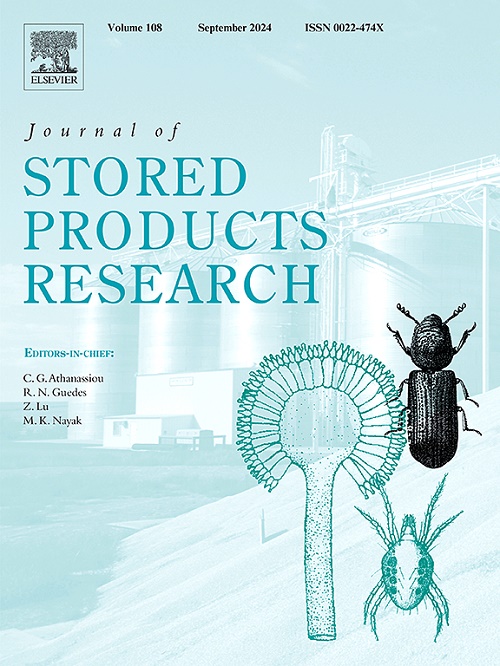贮藏产物螨腐酪螨实验感染红僵菌和沃尔巴克氏菌后,培养物的适合度降低
IF 2.7
2区 农林科学
Q1 ENTOMOLOGY
引用次数: 0
摘要
腐食Tyrophagus purescentiae是一种世界性的食品和动物饲料害虫。螨种群的微生物组组成不同,导致其适应性的变化。贮藏产物腐殖螨的培养常常被细胞内的红毛菌属和沃尔巴克氏菌属之一单独感染。未观察到自然发生的多重感染(红/沃尔巴克氏体)培养。在实验室条件下,我们将两种单感染螨培养物,即Cardinium-infected (5L和5S)和Wolbachia-infected (5N和5P)进行混合,得到四种实验培养物(5LN, 5LP, 5SN和5SP),每种培养物感染每种内共生菌。以种群生长量为适应度指标,采用单螨特异性引物PCR鉴定亲本培养和混合培养中红毛螨和沃尔巴克氏体的流行情况。在实验开始时,实验培养物的种群增长低于亲本。6个月后,5SN和5SP的适合度高于5LP和5LN。5SN和5SP的群体增长与亲本5P和5S的群体增长没有差异。6个月后,红螨感染6个,沃尔巴克氏体感染5个,非共生1个。红螨感染个体的比例(45%)大于沃尔巴克氏体感染个体的比例(25%),表明红螨感染的螨比沃尔巴克氏体感染的螨具有适应性优势。虽然培养物是多重感染的,但双重感染螨是罕见的(7%)。这些结果表明,红柱基是导致腐殖霉细胞质不相容的主要原因。结果表明,胞内共生菌cardinum和Wolbachia的存在对螨种群的生长有强烈的影响。这些数据支持了微生物群在这种害虫中的重要性。本文章由计算机程序翻译,如有差异,请以英文原文为准。

Cultures of stored-product mite Tyrophagus putrescentiae experimentally infected with Cardinium and Wolbachia presented reduced fitness
Tyrophagus putrescentiae is a cosmopolitan pest of stored food and animal feed. Mite populations differ in their microbiome composition, resulting in variability in their fitness. Cultures of the stored-product mite T. putrescentiae are often singly infected by one of intracellular bacterial genera Cardinium and Wolbachia. No naturally occurring multi-infected (Cardinium/Wolbachia) cultures have been observed.
Under laboratory conditions, we mixed two singly infected mite cultures, i.e., Cardinium-infected (5L and 5S) and Wolbachia-infected (5N and 5P) cultures, to obtain four experimental cultures (5LN, 5LP, 5SN and 5SP), each infected with each of the endosymbionts. Population growth was used as a fitness indicator, and PCR with specific primers for a single mite was used to identify the prevalence of Cardinium and Wolbachia in the parental and mixed cultures.
The population growth of the experimental cultures was lower than that of the parents at the beginning of the experiment. After six months, 5SN and 5SP exhibited greater fitness than 5LP and 5LN. The population growth of the 5SN and 5SP cultures did not differ from that of the parental cultures 5P and 5S. Cardinium-infected mites prevailed in 6 cultures, Wolbachia-infected mites in 5 cultures, and asymbiotic individuals in 1 culture after six months. The proportion of Cardinium-infected individuals (45 %) was greater than that of Wolbachia-infected individuals (25 %), indicating that Cardinium-infected mites had a fitness advantage over their Wolbachia-infected counterparts. Although the cultures were multi-infected, doubly infected mites were rare (7 %).
These results suggest that Cardinium is responsible for cytoplasmic incompatibility in T. putrescentiae. The results revealed that the presence of the intracellular symbionts Cardinium and Wolbachia strongly influenced mite population growth in the experiments. These data support the importance of the microbiome in this pest.
求助全文
通过发布文献求助,成功后即可免费获取论文全文。
去求助
来源期刊
CiteScore
5.70
自引率
18.50%
发文量
112
审稿时长
45 days
期刊介绍:
The Journal of Stored Products Research provides an international medium for the publication of both reviews and original results from laboratory and field studies on the preservation and safety of stored products, notably food stocks, covering storage-related problems from the producer through the supply chain to the consumer. Stored products are characterised by having relatively low moisture content and include raw and semi-processed foods, animal feedstuffs, and a range of other durable items, including materials such as clothing or museum artefacts.

 求助内容:
求助内容: 应助结果提醒方式:
应助结果提醒方式:


